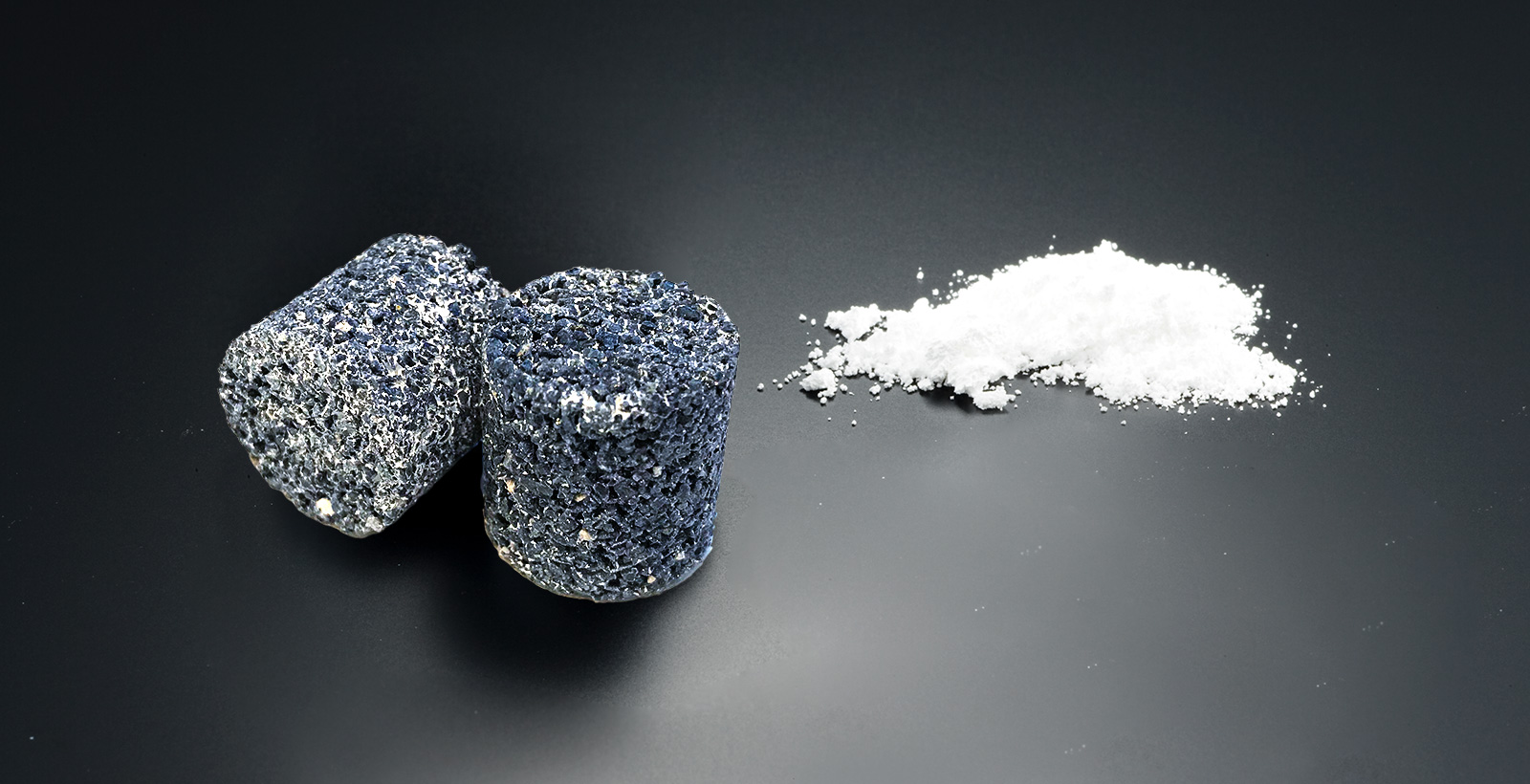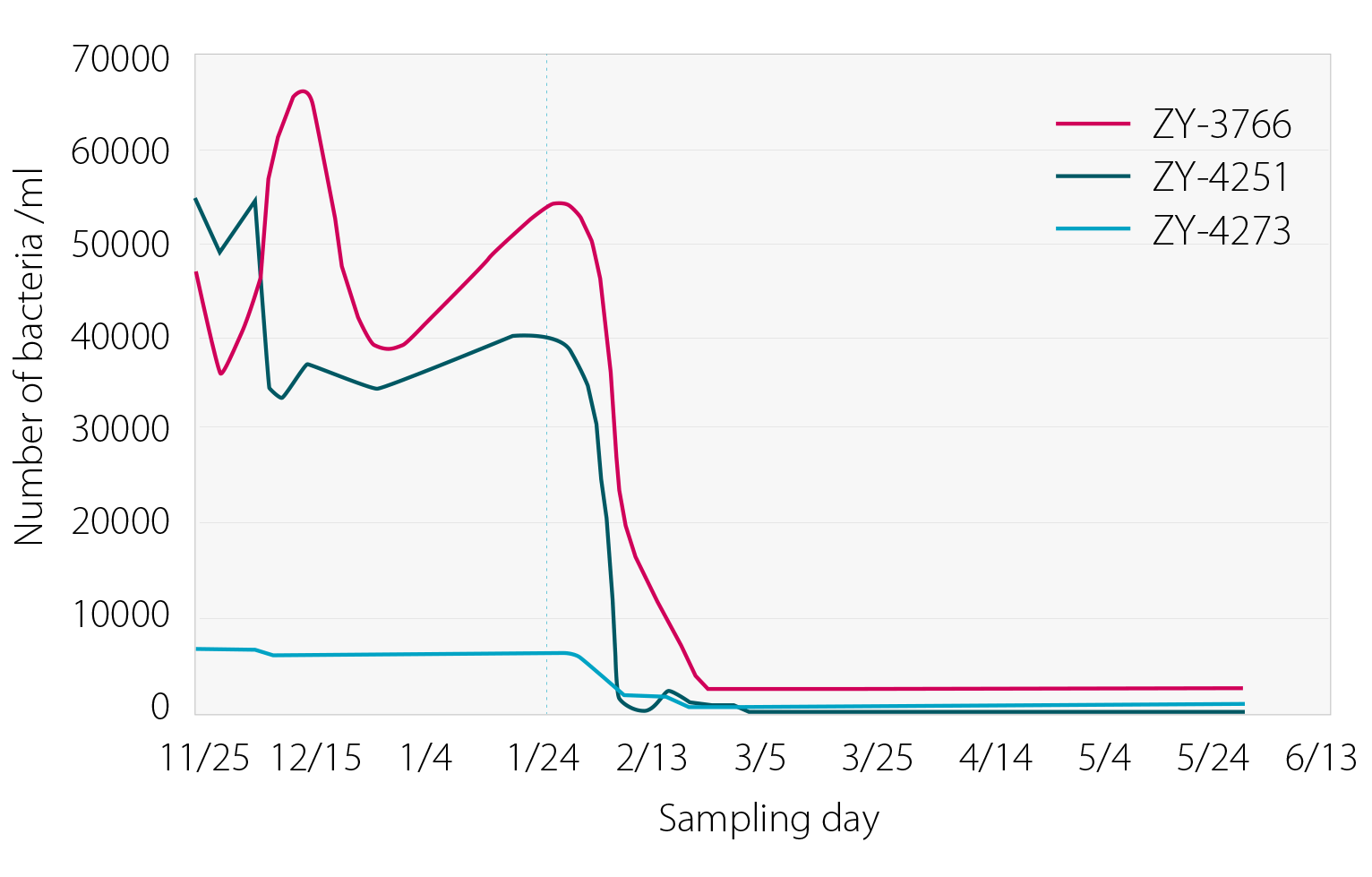
Silver-Based Inorganic Antibacterial Agent
LATP-Ag
SUMITA’s silver-based inorganic antibacterial agent (LATP-Ag) is a non-elution antibacterial agent which is an oxide crystal produced with our original method, the oxide crystal carrying silver ion which exhibits antibacterial activity.
Since silver ion is firmly bonded to an oxide crystal carrier, SUMITA’s LATP-Ag hardly causes elution of silver ion, enabling excellent durability of antibacterial property. Regarding the mechanism for antibacterial activity of non-elution inorganic silver-based antibacterial agent, it is presumed that silver ion catalyze a reaction that results in the production of active oxygen (the hydroxyl radical, •OH) from dissolved oxygen (O2) in solution, and the active oxygen causes bacterial cell death.
Our LATP-Ag is an inorganic oxide having excellent chemical stability and low toxicity, and is superior in heat resistance and light resistance.
Advantages
- Antibacterial properties
Silver ion performs superior antibacterial properties and wide antibacterial spectrum (see various tests results below). - Silver holding ability
LATP-Ag hardly causes elution of silver ion, enabling excellent durability of antibacterial property. - Heat resistance
LATP-Ag is stable and does not change in quality and antibacterial properties even at temperature over 1000℃. - Water resistance
LATP-Ag exhibits superior moisture absorption resistance and is stable under high temperature and high humidity. - Chemical resistance
LATP-Ag maintains its stability in pH 1-13, and for organic solvents. - Light resistance
LATP-Ag keeps its quality and antibacterial properties after long hours of exposure to a sunlight.
Supply Forms
- LATP-Ag powder (particle diameter of less than 10μm)
- LATP-Ag Cylindrical block* (diameter of 19 mm and height of 19 mm)
* LATP-Ag powder is baked on the porous cylindrical block. Since antibacterial blocks are easy to handle, and have a high specific surface area, the blocks gain a high contact efficiency with bacteria, enabling excellent antibacterial activities.
Applications
- LATP-Ag powder and blocks as antibacterial agents/materials and related articles
- LATP-Ag blocks for antibacterial treatment (e.g. putrefaction prevention in the water-soluble cutting liquid for metal processing)
CAUTION: DO NOT use the products in areas, such as fish tanks, where fish, water creature, pets or native animals could be harmed.
MIC (Minimum Inhibitory Concentration) Test Result
The following data shows the MIC (minimum inhibitory concentration) test result of various microbes after adding LATP-Ag in each microbe culture medium.
Note: The Minimum Inhibitory Concentration (MIC) is the smallest concentration of an anti-microbial agent that inhibits the growth of bacteria. Hence, lower MIC values indicate higher efficacy.
Using LATP-Ag Powder
| Tested bacterial isolate | Features | MIC (ppm) |
|---|---|---|
| Colon bacillus | Bacterial contamination index for food. The bacillus which has pathogenicity can cause food poisoning. | 62.5 |
| Staphylococcus aureus | food poisoning bacillus, a common cause of skin infections. | 125 |
| Pseudomonas aeruginosa | Observed and breeds in wounds and in food. Bacterium that can cause disease in plants and animals, including humans. | 62.5 |
| Salmonella | It has pathogenicity for humans and animals, usually takes the form of a self-limiting food poisoning, typhoid disease and enteritis. | 125 |
| Bacillus cereus | This bacillus widely distributes in soil, dust and water. This bacillus is food putrefying bacteria, and can cause food poisoning. | 125 |
| Saccharomyces | A genus of fungi that includes many species of yeasts for food fermentation. | 125 |
| Candida yeast | A type of yeast that can cause human's Candidiasis as pathogenic yeast. | 250 |
| Aspergillus niger | A fungus that causes a disease called “black mold” on certain fruits and vegetables. The fungus can cause allergic reactions. | 1000 |
| Penicillium (blue fungi) | A fungi that can cause food spoilage. Some species are known to produce toxic compounds (mycotoxins).The spores can trigger allergic reactions. | 125 |
Result of Bacteria Population Measurement in Test Liquid (Storage Temperature of 25℃)
Using Antibacterial Blocks
| Tested bacterial isolate | Classification | Number of bacterial cells /ml | ||||
|---|---|---|---|---|---|---|
| At the beginning | After 1 hour | After 3hours | After 8hours | After 24hours | ||
| Pseudomonas | Test liquid | 5.6×104 | - | - | - | 0 |
| Control (comparison) | - | - | - | 1.1×105 | ||
| Legionella | Test liquid | *** | 1.2×105 | 3.6×102 | <10 | <10 |
| Control (comparison) | 2.1×106 | 1.3×106 | 9.1×105 | 1.0×106 | 3.5×105 | |
In the antibacterial test, LATP-Ag blocks were brought into contact with Pseudomonas and Legionella. After 8 and 24 hours, each bacteria was annihilated. The test shows high antibacterial properties of LATP-Ag.
Putrefaction Prevention in the Water-Soluble Cutting Liquid for Metal Processing
Number of bacteria (Using Antibacterial Blocks)
Antibacterial effect on putrefactive bacteria
After LATP-Ag blocks were charged into the water-soluble cutting liquid for metal processing on January 24, the number of three putrefactive bacteria decreased.

Safety Test
| Test item | Summary of results |
|---|---|
| Acute toxicity (mouse) | Acute toxicity test shows that acute oral minimal lethal dose (MLD) of 5000 mg/kg body weight, and LATP-Ag is extremely low acute toxicity. |
| Mutagenicity test (microbes) | Negative |
| Primary skin irritation test (rabbits) | Negative (no dermal responses erythema/ eschar or edema were found) |
| Dermal toxicity (rats) | Dermal toxicity test shows that dermal minimal lethal dose (MLD) of 2000 mg/kg body weight, and LATP-Ag is extremely low acute toxicity. |